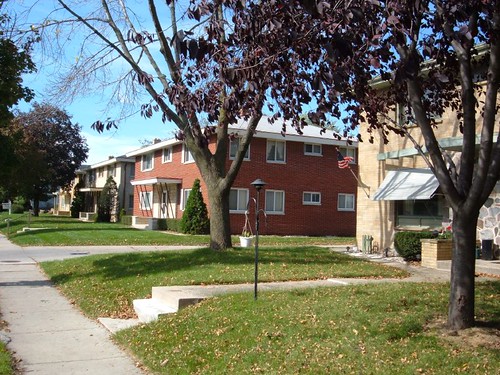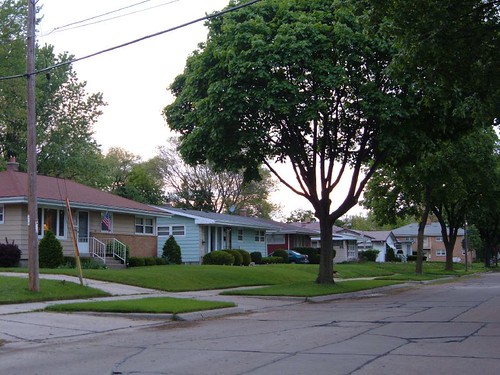I spent Tuesday evening driving all over northwestern Milwaukee. The city expands for many miles in that direction, the only corner of its rectanglular boundaries that hasn't been bitten off by some other municipality. The shift into suburbia is slow and gradual indeed, measurable in tiny increments of decreasing density and increasing yard size.

I don't even have a real name for the kind of development that permeates those endless blocks. It's old suburbia, the kind now known as "inner ring" -- developed between the World Wars, or in the boom years immediately after the second one. It's more spread out than the older streetcar suburbs where I like to make my home (St. Louis's Central West End, West Philly, and now Milwaukee's East Side). But it's not the endless, faceless sprawl of modern suburbia, either.

The buildings of commercial strips found at major intersections still come out to the street, still work to establish major intersections as places instead of just real estate. The houses still have some relationship to each other. The street wall is lower, wider, and less defined, but it's still there. There's some traces of City Beautiful planning, mostly in the form of wide boulevards with grassy medians down the middle. Small apartment buildings are plentiful -- little individual buildings that could almost pass for mid-sized houses, holding two apartments on each of two floors. The houses are compact, often small, some to the point of being cottages. Small traces of Mid-Century Modern enliven them: angled metal pole columns support porch roofs; horizontal slat fences define yards and balconies; large geometric patterns break the monotony of garage doors.

Yet in Milwaukee, it's still something of what Jane Jacobs described as "the great gray zones" -- not the lush, rustic countryside, not the pleasant charm of a small town, yet not dense enough to support the true pulsing life of a city, either. It's a step up from modern suburbia, but just barely. Most of the benefits are superficial -- and even those have diminished as this zone of expansion has been tarnished by age. The architecture has hints of what it was emulating, but the truly superlative moments are few and far between. Demographically, almost everywhere I went last night was inhabited by black people, just like the neighborhood that contains the diminished parish of St. Stephen Protomartyr... and long, sad experience whispers to me that predominantly black populations all too often tend to be poor and beset by a common set of social ills. Some of the neighborhoods show the tell-tale signs of decline, the early notes of people starting not to care or not having the money to keep things up. It's an odd thing to see in what are essentially Modern buildings, but many of them are pushing 50 years old now -- well past the age when neighborhoods start to get cast off by the well-to-do.
And I fear that, truthfully, there's not much to recommend these places. Their biggest appeal was that they were new, and that they accomodated the automobile more easily than any existing cityscape; neither condition applies today. The terrain is flat, straight, and boring -- Villard Avenue, in fact, ends at a local airport. The streetscapes are cohesive but bland. The density is such that a car is a requirement of daily life. The yards are small and not especially charming. This is the new and future ghetto of Milwaukee, and once it sinks I fear there will never be much reason for it to change.
(On the other hand, some of these areas are quite nice, in a leafy shade-tree-street kind of way. And while I mention "tale-tell signs of decline", the bulk of the buildings I saw appear to be in good to excellent condition.)

And in yet another illustration of how it's hard to see what's right in front of you... I have almost no photographs of the places I'm describing. They didn't strike me as remarkable, so I never documented them, even though I found them worth writing about. So very strange...
3 comments:
Apt description of the part of town I grew up in. Most of the visual character of the area was lost when the stately arcades of elms vanished, and some sense of place evaporated when the harp streetlights were replaced by standard-issue generic fixtures.
That said, at least until the early seventies, these neighborhoods were phenomenally safe, had some very high quality public schools, a great many significant and well patronized outdoor and indoor recreation opportunities, and abundant, varied (though not really deluxe), easily accessible commercial blocks, strips and centers. Also, at least below Silver Spring Dr. and east of 76th Street, bus service was frequent enough and routes near enough that one could get by comfortably without a car, though admittedly that was not a popular option.
It's personally painful for me to revisit this area of the city now and compare it to it's prosaic but bountiful past.
But isn't it a step up for the poor, for whom all housing is passed down to? The houses present filled neighborhoods of modern buildings with more modern amenities than even a 1910s house or earlier one that so many lower income people were marketed into. In time major cities destroyed houses in those older inner city neighborhoods. At least in older suburbia, schools are better, buildings newer, neighborhood built environments are intact, and governments have paid more attention to public amenities and infrastructure. Metropolitan areas are never freezed in time, and thankfully those typically disadvantaged are now being given opportunities for better things and better places; no more living in the ghettos where only a few houses remain on a block, buildings fall down, schools cannot educate, and despair and neglect of minority neighborhoods is common.
This is a social justice and social equity win in America!
Post a Comment